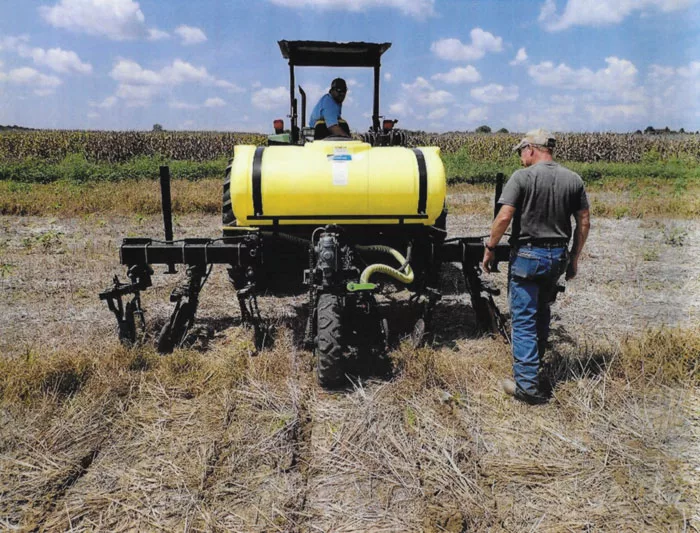Several years back John Miller had an epiphany while staring at a farm magazine cover photo. The picture featured a Mid-South farmer’s home-brew fertilizer applicator designed to place liquid nutrients in the valleys next to raised beds — a common practice in the Mississippi Delta.
Miller, who farms 2,700 acres of corn and soybeans in Catlin, Ill., and owns Nitrogen Sealing Systems, a company specializing in aftermarket fertilizer placement equipment, recalls thinking, “There has to be a better way than placing fertilizer in the middles and waiting for it to migrate to the bedded crop!”
Precision Placement
A long-time advocate of precision placement of crop nutrients, Miller’s company was born when he began working on designs to prevent atmospheric loss of nitrogen behind injector and knife applicators which consistently left an open slot behind the application.
“I knew if the nitrogen was not covered it would be lost,” Miller explains. “At that time there were no sealers on liquid nitrogen applicators, so we built a closing system to protect our nitrogen investment and increase yields.”
Miller’s on-farm success launched NSS in 2013, and today the company provides double coulter units for Blu-Jet, Fast, Yetter, Case Nutri-Placer, Ag Systems, Ag Spray and several other ammonia applicators. Becks’s Practical Farm Research has shown consistent and sizable corn yield increases with NSS sealers over several years.
“I continually try to convince growers it’s better to fertilize in zones rather than fertilize the whole farm,” Miller explains. “That’s why the bedded cotton applicator in the magazine picture intrigued me. Why not build a machine that would place the fertilizer near the root zone on the bed, and cover the slot at the same time?”
Knowing cotton producers try to avoid throwing soil next to growing cotton plants to prevent stem damage and potential plant disease, Miller designed a 4-row unit with a 200-gallon tank, a John Blue pump and a delivery system for testing at the Agricenter International in Memphis.
“The unit features a gauge wheel, which runs next to the cotton row and prevents the covering disc from penetrating the ground and damaging roots,” he says. “Nitrogen is applied ahead of the disc, which rolls the soil toward the cotton row. But before the soil can roll up against the cotton, it flows against the side of the rolling depth wheel.”
Replicated Testing
In 2020, Agricenter research director Bruce Kirksey conducted a four-replication test of Miller’s applicator design against a traditional knife applicator in cotton. Each design applied 60 pounds of liquid nitrogen (N) per acre.
At harvest, the NSS plots averaged 1,325.8 pounds of lint per acre, while the nearby traditional knife system averaged 1,101.1 pounds per acre. Based on a cotton price of $0.80 per pound, the nearly 225 pound increase was worth $179.76 per acre.
“It’s better to fertilize in zones rather than fertilize the whole farm…”
In separate replicated Agricenter corn trials in 2020, the NSS technology showed a nearly 12-bushel yield difference over the knife applicator. Using 150 units of N per acre, the NSS plots binned an average 183.2 bushels per acre, compared with the knife applicator’s 171.4 bushels per acre. There, a $5.20 corn price equates to a positive $61.36 per acre difference.
In 2021, overall cotton yields at the Agricenter test site were down, but in the subsequent trial, the NSS plots produced an average of 741.6 pounds of lint per acre, against the traditional knife system’s 709.2 pounds for a positive difference of $37.31 per acre.
No fertilizer placement corn trials were conducted in 2021.
“Observing the cotton under the two treatments, we saw green-up in 5-7 days where the NSS applicator ran, compared with 2-3 weeks behind the knife applicator,” Kirksey explains.
“This supports my theory that better placement of nitrogen is important to crop growth,” Miller says. “The roots don’t have to go looking for their nutrients.
“There’s so much efficiency to be gained by better placement of fertilizer, particularly now that precision agriculture allows us to work at sub-inch tolerances,” he says. “With applicators that can feed the root zone, while at the same time protecting the crop from machine damage and soil mounding, we’re seeing that efficiency in the Memphis trials.”
Miller says he plans to continue testing his design in cotton and corn at the Agricenter and hopes to bring additional trials on board at the University of Tennessee, Mississippi State University and the University of Arkansas.
Meanwhile, he says he’s in talks with shortline manufacturers in the southern U.S. for possible collaboration on the NSS design that can be easily scaled beyond the 4-row test unit’s size. Also, he says the design can be used on bedded fields or as a strip-till implement on the flat.







